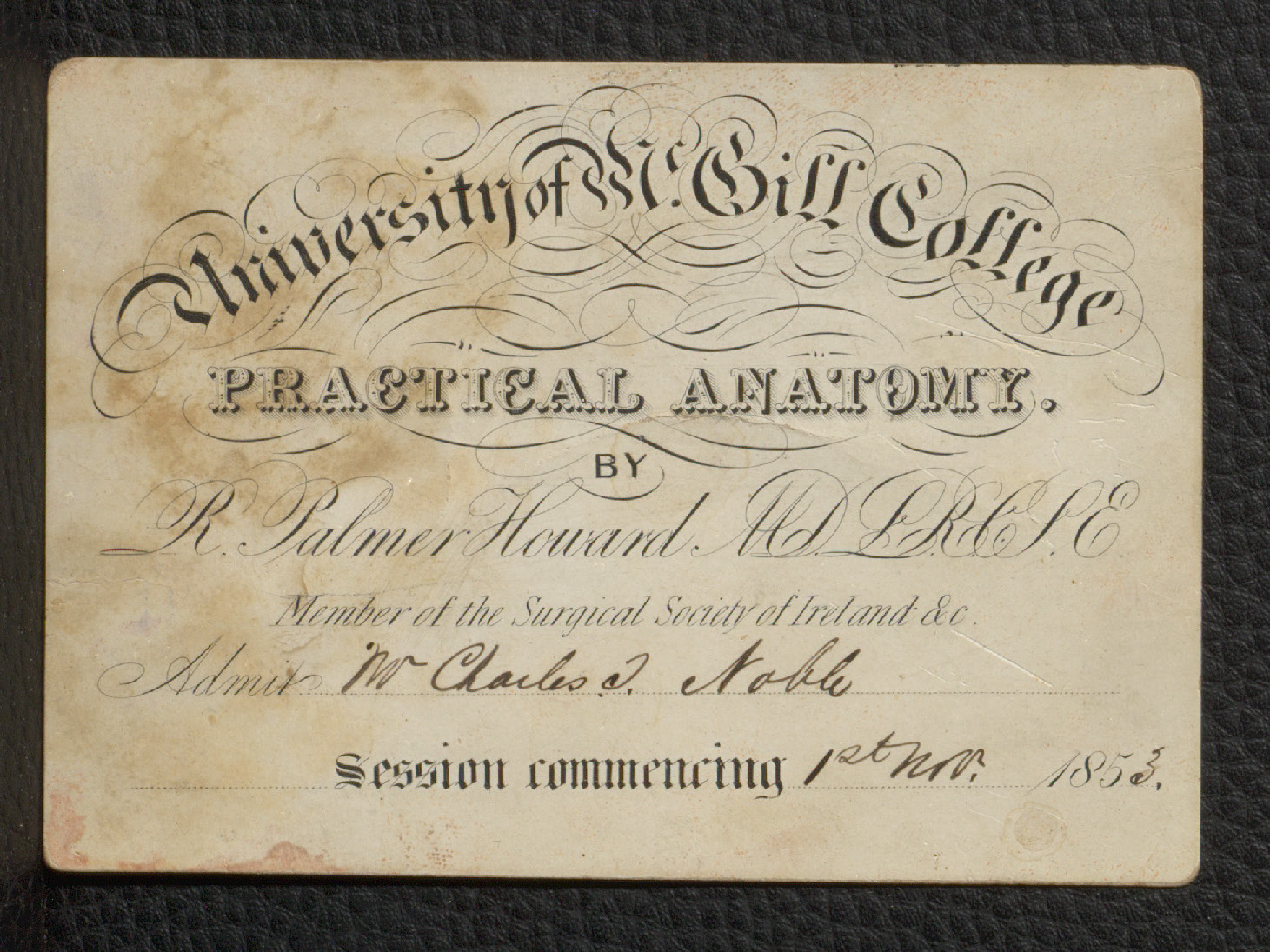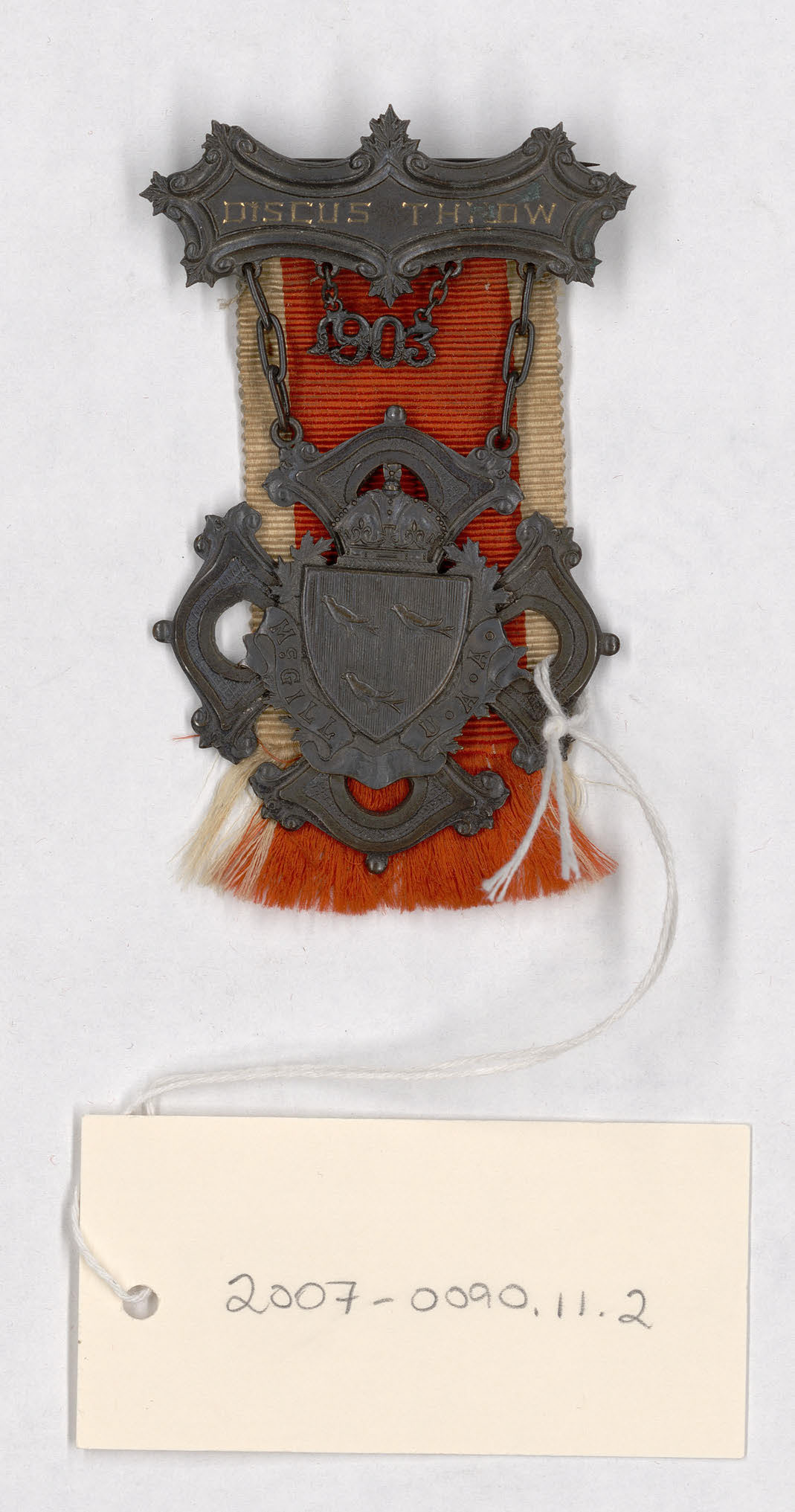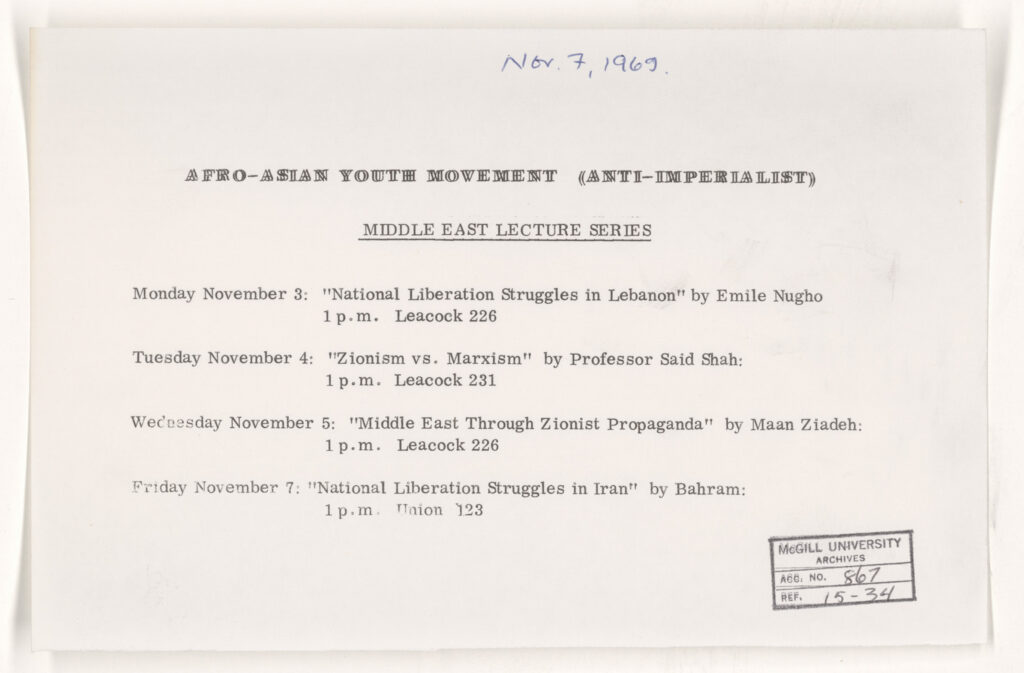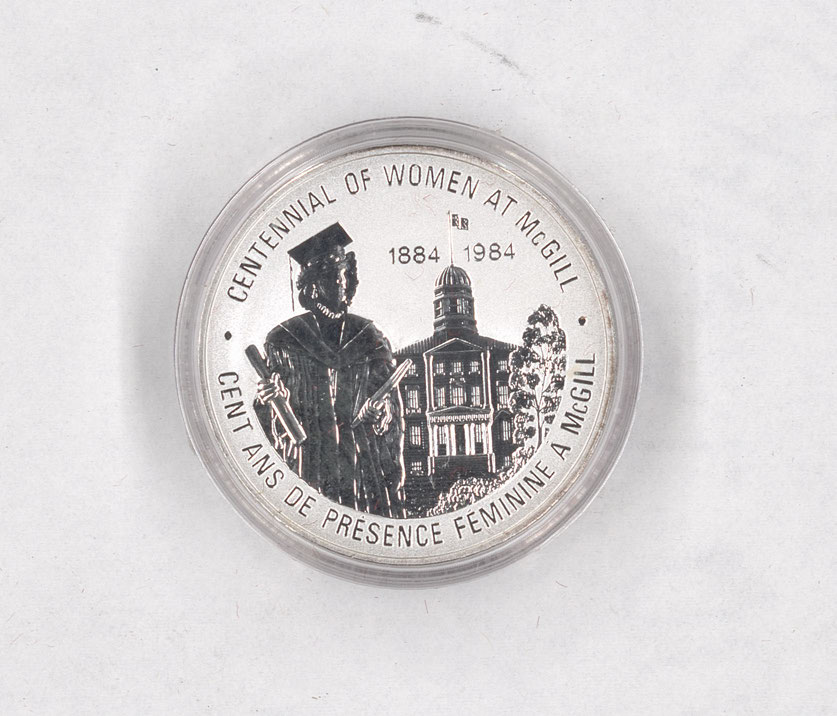By Aeron MacHattie, Archivist, Collection Services
As the McGill community commemorates its bicentennial, it might be an opportune time to find markers by which to measure the ways McGill has grown, both to celebrate achievements and to identify the areas in which growth and further change is required. One possible lens through which to view this change is the McGilliana: 200 Years of Student Life exhibition, now online. The exhibition includes 200 items, organized into ten thematic areas: Academics, Arts, Athletics, Activism, Campus, Convocation, Leisure, Military, Social Events, and Student Organizations. It samples from the collections of the McGill University Archives to offer glimpses of student life throughout the 200 years of McGill’s history through objects that students used and interacted with in their daily lives. Here are just a few of the objects included in the exhibition, with some reflections about the eras that they represent.

1821-1871
Before it was the bustling campus we know today, McGill’s primary focus was medicine. The first medical degree awarded in Canada was granted in 1833 by McGill’s newly established Faculty of Medicine. This admission card for a practical anatomy course gives us a taste of these early days of McGill. The Faculty of Arts was established in 1843, followed soon after by the Faculty of Law in 1848. These three faculties represented McGill’s academic core for another fifty years. The student body at this time was comparatively limited – exclusively male, and predominately wealthy and white. In 1848, William Wright was the first person of colour to earn a medical degree in Canada. Women were first admitted as students to McGill in 1884.
Image: Admission card for practical anatomy course, 1853. McGill University Archives, MG 4319 (4319-02-042).

1871-1921
The later 19th century and early 20th century was a period of significant change at McGill. Begun under J.W. Dawson’s principalship, this era saw the school expand to include programs in architecture, engineering, physics, chemistry, and dentistry – with a corresponding expansion of the student body. By the 1920s, female students outnumbered male students in the Faculty of Arts. This is also the period during which McGill yearbooks first began to be published. These yearbooks are one of the richest sources of information about student life at McGill, and an excellent companion to the McGilliana exhibition, representing everything from sports events to student theatre all the way back to 1898.
Image: Discus Throw Medal, 1903. McGill University Archives, MG 4319 (4319-07-020).

1921-1971
This period was one of great social tumult, from the Roaring 20s to the Depression, followed by the Second World War and the enormous cultural changes of the 1960s. The end of this period, in particular, saw an unprecedented level of student political engagement on campus. This included protest against the Vietnam War and South African Apartheid, advocacy for women’s rights, defense of the rights of the Quebec people, and educational campaigns related to anti-imperialist and anti-fascist movements across the globe.
Image: Afro-Asian Youth Movement ephemera, 1969. McGill University Archives, MG 4319 (4319-02-015).

1971-2021
Reflecting on more recent history, one can see the ways that the McGill community has built on the radical changes that happened in McGill’s past and the pathways they open to possible futures. One can reflect on the way that the 1960s and 70s promoted a culture of protest and political engagement on campus and see that the work of building a just and inclusive campus has only just begun. One can celebrate 137 years of women at McGill and acknowledge that our culture’s understanding of gender is becoming more fluid and that there is much more to be done to support the school’s and the city’s trans communities. It is possible to celebrate an expanding and diversifying student body while also committing to breaking down the remaining barriers to accessing education.
Image: Centennial of Women at McGill medal, 1984. McGill University Archives, MG 4319 (4319-07-045).
Explore the McGilliana: 200 Years of Student Life exhibition online.
A selection of exhibition items are on display in the McLennan Library Building Lobby until December 21, 2021. Current building access information here: https://www.mcgill.ca/library/covid-19-faqs
Further reading
Learn more about the McGill Bicentennial here.
Explore the McGill University Yearbooks
McGilliana : Regard sur le passé et penchant vers l’avenir, les œuvres les plus frappantes issues de 200 ans de vie étudiante
Par Aeron MacHattie, archiviste
Alors que la communauté de McGill commémore son bicentenaire, le moment est peut-être venu de repérer des jalons qui permettent de mesurer la croissance de McGill, et ce, tant pour souligner les victoires de notre communauté que pour cerner les volets qui nécessitent une croissance accrue et d’autres changements. Pour ce faire, on peut regarder par la lorgnette de la McGilliana : 200 ans de vie étudiante, diffusée en ligne. L’exposition recèle 200 articles regroupés sous dix volets thématiques : activisme, événements sociaux, arts, athlétisme, campus, collation des grades, études, loisirs, associations étudiantes et forces armées. Elle puise à même les fonds des Archives de l’Université McGill pour offrir des aperçus de la vie étudiante au fil des 200 ans d’histoire de McGill au moyen d’objets que les étudiants ont utilisés, et avec lesquels ils ont interagi, au quotidien. En voici certains retenus pour l’exposition, accompagnés de réflexions sur la période qu’ils représentent.

1821-1871
Avant de devenir le campus trépidant d’aujourd’hui, McGill s’attache d’abord et avant tout à la médecine. Ainsi, la Faculté de médecine, fraîchement établie, remet le premier diplôme au Canada dans cette discipline en 1833. Ce carton d’invitation à un cours d’anatomie pratique nous donne un aperçu du ton des premiers jours de McGill. Établie en 1843, la Faculté des arts précède la Faculté de droit qui voit le jour en 1848. Ces trois facultés constituent le cœur universitaire de McGill pendant encore 50 ans. À cette époque, le corps étudiant est relativement limité, exclusivement masculin et surtout riche et blanc. En 1848, William Wright devient la première personne de couleur à décrocher un diplôme en médecine au pays. Les femmes sont admises à McGill en qualité d’étudiantes en 1884.
Image: Carton d’admission à un cours pratique d’anatomie, 1853. Archives de l’Université McGill, MG 4319 (4319-02-042).

1871-1921
À la fin du XIXe et au début du XXe siècles, des changements importants ont lieu à McGill. Amorcée sous l’égide du principal, J.W. Dawson, cette ère voit l’Université prendre de l’expansion grâce à divers programmes : architecture, génie, physique, chimie et dentisterie, expansion qui se traduit également dans le nombre des étudiants. Dans les années 1920, le nombre d’étudiantes dépasse celui de leurs camarades masculins à la Faculté des arts. Et c’est la période où commence la publication des albums de finissants de McGill. Ces publications, qui figurent parmi les sources d’information les plus riches qui soient sur la vie étudiante à McGill, et dont l’éventail s’étend des activités sportives au théâtre pour remonter jusqu’à 1898, représentent le compagnon tout désigné de l’exposition McGilliana.
Image: Médaille du lancer du disque, 1903. Archives de l’Université McGill, MG 4319 (4319-07-020).

1921-1971
Cette période est marquée par de vastes tumultes sociaux, des années 1920 vrombissantes aux énormes bouleversements sociaux des années 1960, en passant par la Grande Dépression et la Seconde Guerre mondiale. La fin de cette période, notamment, voit un engagement politique étudiant sans précédent sur le campus qui a englobé les contestations de la guerre du Vietnam et de l’apartheid sud-africain, la défense des droits des femmes et ceux du peuple québécois, de même que des campagnes d’éducation contre les mouvements impérialistes et fascistes dans le monde entire.
Image: Document éphémère sur le mouvement afro-asiatique, 1969. Archives de l’Université McGill, MG 4319 (4319-02-015).

1971-2021
Plus près de nous, l’observateur peut constater que la communauté McGill table sur les changements radicaux du passé de l’Université et des voies que la mouvance ouvre sur un futur possible. Il peut réfléchir sur la manière dont les décennies 1960 et 1970 nourrissent une culture de contestation et d’engagements politiques sur le campus et constater que l’édification d’un campus juste et inclusif ne fait que commencer. Il peut aussi célébrer les 137 années de présence féminine à McGill, reconnaître que notre compréhension culturelle des genres gagne en souplesse et qu’il reste encore tant à faire pour épauler les communautés trans de l’Université et de la ville. On peut célébrer l’expansion et la diversification du corps étudiant tout en s’engageant à abattre les derniers obstacles à l’accès à l’éducation.
Image: Médaille commémorative du centenaire de la présenceféminine à McGill, 1984. Archives de l’Université McGill, MG 4319 (4319-07-045).
Vous pouvez explorer l’exposition McGilliana : 200 ans de vie étudiante ici même.
Une sélection des artéfacts de l’exposition se trouve dans le hall de la bibliothèque McLennan jusqu’au 21 décembre 2021.
Voici comment s’y rendre : https://www.mcgill.ca/library/covid-19-faqs.
Lectures complémentaires
Renseignez-vous ici au sujet du bicentenaire de McGill.
Explorez les albums des finissants de l’Université McGill.













Leave a Reply
You must be logged in to post a comment.